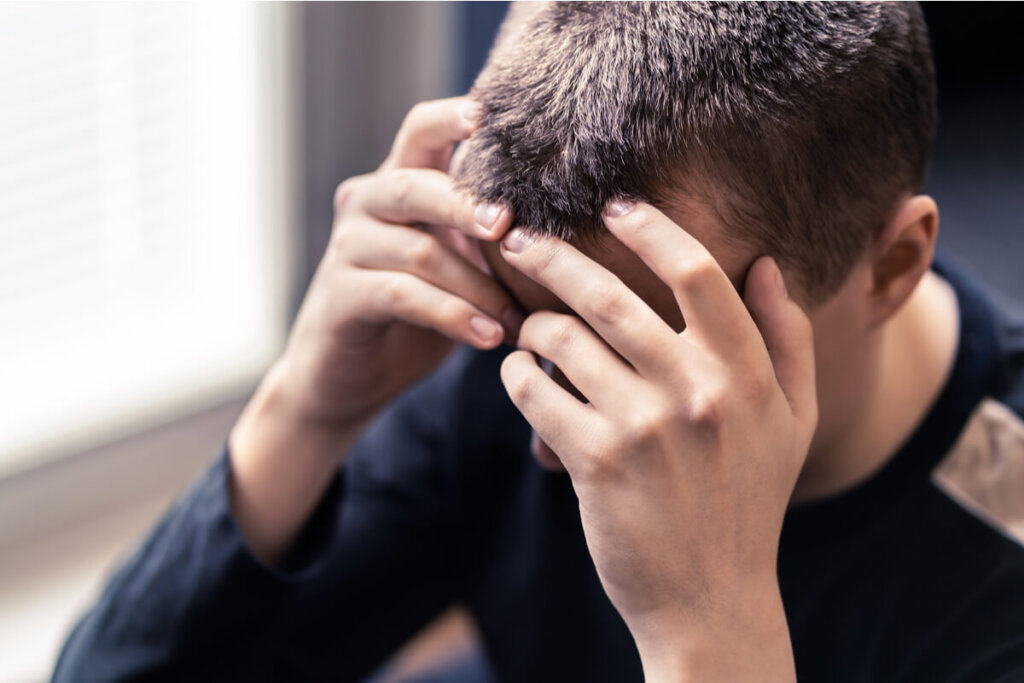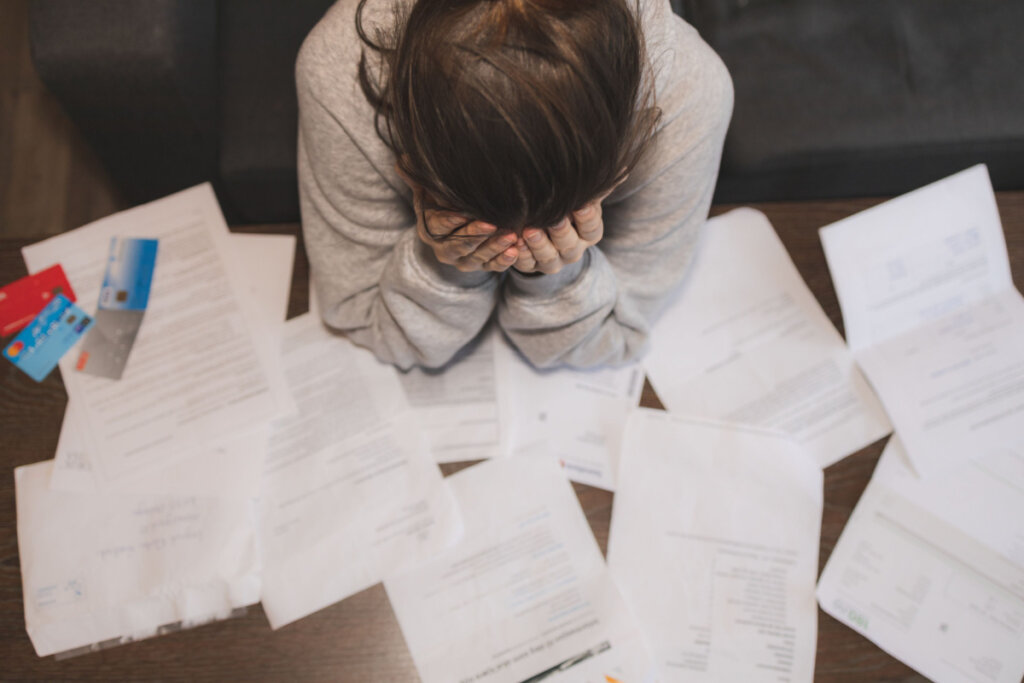Why Teen Anxiety Is on the Increase


Written and verified by the psychologist Cristina Roda Rivera
The pandemic was a catalyst for many mental health problems in children and adolescents. Indeed, the confinement really exposed the mental vulnerability of the younger generations. As a matter of fact, anxiety disorders skyrocketed both in this and other sectors of the population.
Data on psychological disorders in the adolescent population is devastating. A whole new series of factors have been added to the usual hormonal changes and challenges that the passage to adulthood entails. This has led to the worst imagined consequences. For instance, an increase in self-harm and suicides.
Today, if you were to ask a teen what characterizes this time in their life, it’s highly likely that they’d say a total absence of meaning. A few years ago, however, they’d have identified more concrete problems. Yet, nowadays, they often feel disorientated about what their lives really feel like and what it actually means to have goals.
Without being able to see their friends every day and being overloaded with extracurricular activities, they don’t have time to develop the sense of existence that’s generated in spontaneous and not-so-premeditated situations. The kinds of situations where they might be in contact with nature or be able to do nothing without feeling guilty. The only tool they have left to ‘entertain’ themselves today is a cell phone or a tablet. At the same time, they feel like the adults around them are forever criticizing them.

Why the increase in teen anxiety?
A study that was conducted into the increased incidence of mental health problems during the pandemic left little doubt about the psychological suffering of young people. In fact, children and teens appeared at the top of the study’s list of victims of their mental health due to confinement.
To assess the possible causes of increased anxiety in teens, we’re going to look at the changes that have occurred in our environment, the kinds that have made everyone more vulnerable.
1. They’ve lost their meaning in life
A study that was conducted with teens on the meaning of life mentioned the feeling of emptiness they feel. On many occasions, they find it overwhelming. They used to be worried about fitting in. Today, they’re extremely skeptical about the real value that their goals might have.
The study claimed that young people consider their family and friends are their main source of meaning.
However, if this is the case, why are the times they’re able to spend with them becoming increasingly reduced?
2. Without direct experiences, teens are often afraid to pick up the phone
When they don’t have daily interactions and experiences with friends and family, they have too much time to ruminate on the past. There’s nothing to distract them and their bodies don’t even get the chance to get tired. Moreover, there’s no genuine and authentic daily experience of contact with others, which is what they need to form their identities.
Only 15 years ago, a teen would talk on the landline phone for hours. They’d go out, make friends, and meet people from other neighborhoods. They’d meet up to see a movie at the cinema, which became a unique shared experience.
Nowadays, they’re too busy, or at least that’s what it feels like. Indeed, they’re always doing something online or watching something. That said, in reality, when it comes to exploring beyond the screens and discovering something new, many of them are completely lost.
3. They feel that they don’t have the same generational values
Another big problem is the generation gap that exists between parents and children today. It’s said that if there’s love and understanding, the family always comes out ahead. Nevertheless, this is also based on the sharing of values, the kinds that aren’t diametrically opposed.
Today, we see teens who are totally disconnected from the tastes and preferences of their parents. In fact, they feel increasingly distant from their values and attitudes.
Previously, this kind of family member was labeled as a black sheep. Today, it seems there’s a whole generation of black sheep. For instance, many young people entering the adult world do so with the feeling that other generations haven’t taken enough care of the planet. Or, they feel they haven’t fought hard enough to end inequality. In effect, they feel that their inheritance is compromising their future.
4. The power of social media
There are increasingly more studies linking time spent on the computer with the symptoms of depression and anxiety. A study published in The Canadian Journal of Psychiatry claims that excess screen time is a factor that intensifies/reproduces anxiety symptoms during adolescence.
When teens reduce their use of social media and computer screens, as well as the time they spend watching tv, their symptoms of anxiety improve.
The Internet is an inexhaustible source of information. It’s also a scenario where truth and quality are confused with lies and garbage. As Generations Y and Z enter the world of work or higher education, the differences between those who grew up with the Internet and those who didn’t are starting to become clearer.
The anxiety and depression disorders of these young people seem to be due, at least in part, to their increased awareness of the world around them. They either feel ‘bored’ when they have to face the world or ‘disgusted’ by what’s happening in another part of the planet. They’re bombarded with so much information, it takes away their energy to face their everyday lives.
Seeing images every day of people who appear to be ‘living the dream’ also causes them anxiety. Whether on social media, at work, or at school, they feel frustrated when comparing themselves to others. This generates anxiety and depression.
Teens have always compared themselves with their closest environment but they used to also interact with it. Today, they compare themselves to the best versions of their online friends and to other celebrities who they feel close to but who, in reality, have absolutely nothing in common with them.
5. They have high expectations of success
Between standardized testing and a culture of achievement, today’s teens experience forms of pressure that their previous generations were virtually unaware of. In fact, all sources of pressure, whether in respect of their studies, first jobs, or social images, have intensified.
The clearest example of this is Japan. It’s the country with the highest suicide rate (14.3 people out of 100,000, according to the WHO). As a matter of fact, between 2017 and 2018, 250 children in elementary, middle, and high schools committed suicide in Japan. This fact can be better understood if we consider the academic pressure that affects all Japanese children. They all aspire to enter good universities and, thus, earn the respect of their families. Naturally, to achieve this, they have to pass extremely difficult entrance exams.

The solution lies in the coordinated work of several social agents
Teens are spending more time in their rooms, talking less, and generating conflicts to highlight their own discomfort. Moreover, they frequently take refuge in social media, avoid stressful situations, and consume harmful substances.
The solutions to these problems must be close and approachable. For example, for a teen with anxiety to adopt a different routine than usual, the new plans must be as accessible and appetizing as possible.
They must begin to participate in their own realities and take part in local activities such as volunteering. This means they’ll be able to develop their social skills and assertiveness at these critical moments in their development.
Teen anxiety can be treated in therapy, but only improves with accessible social resources
Teen anxiety never stops growing, but the solution doesn’t only lie in going to therapy. In fact, the teen attending therapy must still find their essential values. They must also be determined to achieve their goals. However, the responsibility doesn’t only lie with them.
As a matter of fact, their mental health is also the responsibility of their parents. They must guarantee that their children have the right to free time, as well as to spend quality time with their families. For this reason, governments and health agents should incorporate subsidized primary, secondary, and tertiary prevention plans into their agendas to guarantee access to mental health plans and treatments.
Governments should also ensure that work and study programs are offered to young people with the ultimate aim of offering them worthwhile jobs. Furthermore, programs to allow them access to affordable housing should be implemented. This will enable them to become independent from their parents.
Finally, we must take a step forward in defending the services that take care of everyone’s mental health.
All cited sources were thoroughly reviewed by our team to ensure their quality, reliability, currency, and validity. The bibliography of this article was considered reliable and of academic or scientific accuracy.
- Khouja JN, Munafò MR, Tilling K, Wiles NJ, Joinson C, Etchells PJ, John A, Hayes FM, Gage SH, Cornish RP. Is screen time associated with anxiety or depression in young people? Results from a UK birth cohort. BMC Public Health. 2019 Jan 17;19(1):82. doi: 10.1186/s12889-018-6321-9. PMID: 30654771; PMCID: PMC6337855.
- PSICOSOC. Centro de Estudios Superiores Don Bosco. El sentido de vida en los jóvenes: redes
sociales, relaciones significativas y actividades de ocio. - Estilo AMA Bueno-Guerra N. COVID-19 e Impacto Psicológico. enciclopedia _ 2022; 2(1):400-408. https://doi.org/10.3390/enciclopedia2010024
This text is provided for informational purposes only and does not replace consultation with a professional. If in doubt, consult your specialist.








